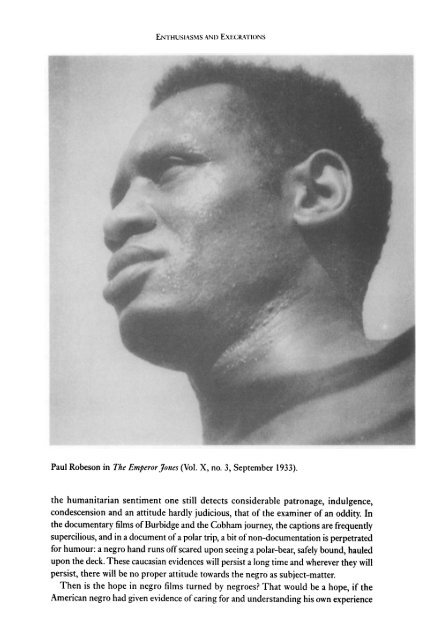close up - Monoskop
close up - Monoskop
close up - Monoskop
You also want an ePaper? Increase the reach of your titles
YUMPU automatically turns print PDFs into web optimized ePapers that Google loves.
ENTHUSIASMS AND EXKCRATIONS 31<br />
of seeing and understanding, nor the possible exploitation of the pedagogy of cinema<br />
for political ends that Macpherson is concerned with - as, say, Walter Benjamin might<br />
have been. Macpherson is exclusively concerned with the implications of Eisenstein's<br />
'new art of tone-film' for a phenomenology of skilled spectatorship. Bearing in mind<br />
his slogan in his first editorial - 'The film for the film's sake' - one might almost say<br />
that this is Eisenstein reread through Pater. Macpherson quotes at length from Hanns<br />
Sachs's article 'Film Psychology'. 7 His own conclusion focuses on the aesthetic<br />
possibilities of the overtones created for the spectator through montage:<br />
'See' is inaccurate. 'Hear' is inaccurate. 'See and hear' is inaccurate. Sense, says<br />
Eisenstein, is the clue to overtone or fourth dimension. I sense - vividly, faintly,<br />
overwhelmingly, not at all. I sense must mean I re-organise, I resound. To see<br />
means little, means nothing, unless it is a process of absorption and creation.<br />
You need only walk round a picture gallery to know this, or to go to the opera,<br />
and realise the moment when you react no more to what you are seeing or what<br />
you are hearing, though, while you remain there, you will continue to see or to<br />
hear. With this saturation point, comes the cessation of creative energy that<br />
makes appreciation and assimilation. 'I sense' (I resound) is, therefore the<br />
paramount consideration and subject to almost no restriction. Psychicphysiological<br />
experience, conscious and unconscious, active and passive,<br />
symbolic and 'realistic', is a source of infinite s<strong>up</strong>ply, and authentic on almost<br />
any plane of organised, scientific selection. The new overtone montage will<br />
avoid saturation. It will stimulate and provoke, thwart and incite, until response<br />
is absolute. 8 [italics original]<br />
The same concern with the power of the cinematic image to transform the objects it<br />
represents and to create a unique aesthetic experience for the film spectator can be<br />
found in Robert Herring's account of 'magic' in cinema. Its source, whether conscious<br />
or not, is identified in Harry A. Potamkin's discussion of French cinema when he<br />
refers in passing, and slightly dismissively, to the term photogenie. This was developed<br />
by the impressionist, or modernist, film-makers working in France in the 1920s, and<br />
has generally been abandoned as irredeemably bound <strong>up</strong> with a confused and<br />
anti-theoretical mysticism. In 1981, however, in Afterimage, a journal that in its own<br />
way reworked Close Up's commitment to radical formal experimentation in film, Paul<br />
Willemen offered a limited defence of the term:<br />
As the 'law of the cinema', [photogenie] clearly sets in place a viewer's aesthetic.<br />
The defining characteristic of cinema is said to be something that pertains to the<br />
relationship between viewer and image, a momentary flash of recognition or a<br />
moment when the look at... something suddenly flares <strong>up</strong> with a particularly<br />
affective, emotional intensity. The founding aspect of cinematic quality, instead<br />
of its specificity, is located, not in the recognition of an artistic sensibility or<br />
intentionality 'behind' the screen, as it were, but in the particular relationship<br />
s<strong>up</strong>ported or constituted by the spectatorial look, between projected image and<br />
viewer. As such photogenie is a term mobilised to demarcate one set of viewers -<br />
those able to 'see' - from others. In this context it functions like a mark of

















